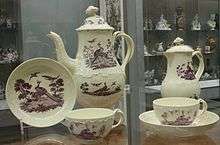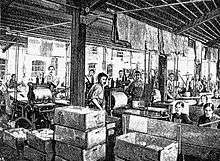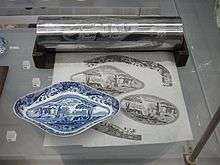Transfer printing



Transfer printing is a method of decorating enamels or ceramics using an engraved copper or steel plate from which a monochrome print on paper is taken which is then transferred by pressing onto the ceramic piece.[1]
Invention
In the 1750s three men made significant advances in the application of printed decoration to ceramic surfaces. In 1751 John Brooks, a Birmingham engraver, petitioned for a patent for “printing, impressing, and reversing upon enamel and china from engraved , etched and mezzotinted plates and from cuttings on wood and metal...” He was primarily concerned with printed decoration on enamels – boxes, plaques, medallions, etc. His patent application failed and he moved from Birmingham to London where he continued to unsuccessfully apply for patents. He was likely involved in early printing on enamels at both Bilston—near Birmingham—and at Battersea in London.
Five years after Brooks's first patent attempt, in 1756,[2] John Sadler (in partnership with Guy Green) claimed in a patent affidavit that they had spent the past seven years perfecting a process for printing on tiles and that they could "print upwards of Twelve hundred Earthen Ware Tiles of different patterns " within a period of 6 hours. Sadler and Green printed in Liverpool, where their trade included overglaze printing on tin-glazed earthenware, porcelain, and creamware.
Credit for perfecting transfer printing on porcelain at the Worcester factory in the 1750s goes to Robert Hancock, an eminent etcher and engraver. Richard and Josiah Holdship, the managers of Worcester, were very supportive and involved with Hancock’s work. By the mid-1750s the Worcester porcelain factory was producing both underglaze prints in blue and overglaze prints, predominately in black.
References
- ↑ Fleming, John & Hugh Honour. (1977) The Penguin Dictionary of Decorative Arts. London: Allen Lane, p. 800. ISBN 0713909412
- ↑ Hildyard, Robin. (1999) European Ceramics. London: V&A Publications, p. 90. ISBN 1851772596
External links
| Wikimedia Commons has media related to Transfer printing. |